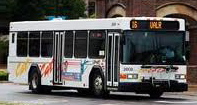UALR Provides Transit Analysis
Two years ago, members of the Central Arkansas Transit Authority (CATA) suggested the regional bus system should begin converting its fleet from diesel fuel to alternatives that might be cleaner burning and more sustainable, such as compressed natural gas.
But was this the time to make the expensive conversion? CATA managers asked the question, and UALR delivered an answer.
 A team with diverse expertise ranging from emission chemistry to economics was assembled representing the university’s Colleges of Science and Mathematics (CSAM), Engineering and Information Technology (EIT); Business, and Professional Studies. They conducted an extensive indisciplinary analysis of alternative fuels for buses with the goal of guiding future bus purchases by the agency.
A team with diverse expertise ranging from emission chemistry to economics was assembled representing the university’s Colleges of Science and Mathematics (CSAM), Engineering and Information Technology (EIT); Business, and Professional Studies. They conducted an extensive indisciplinary analysis of alternative fuels for buses with the goal of guiding future bus purchases by the agency.
Last week, CATA released the results of the analysis. The bottom line: CATA buses should keep running on diesel before gradually adding diesel-electric hybrid buses instead of converting to compressed natural gas vehicles.
“The strengths and weaknesses of each system was evaluated, including the need for additional infrastructure that would accompany changes to the alternative fuels,” said Dr. Michael Gealt, dean of CSAM and chair of the CATA analysis group.
The professors analyzed the pros and cons of alternative fuels, including biodiesel and diesel – both in conventional and hybrid configurations – and compressed natural gas.
“Components of the study included purchase and maintenance cost of buses with different fuel systems, emission impact on air quality, and community impact,” he said.
CATA operates bus service for Little Rock, North Little Rock, Sherwood, Maumelle and unincorporated portions of Pulaski County in exchange for municipal subsidies covering $9.5 million of the transit authority’s $13.4 million budget.
Eight years ago, CATA ask UALR to conduct a feasibility study of expanding transit services beyond Pulaski County. The result was the 2003 task force study chaired by engineering Professor Yupo Chan titled, “A Call for Regional Leadership: Public Transportation in Central Arkansas.”
The latest study came at the request of CATA officials seeking guidance for future bus purchases as parts of the fleet approach the end of their 12-year life cycle.
“Choosing a path for the future bus fleet is not a straightforward matter,” Gealt said. “UALR was chosen for this study because it is a neutral party in the discussion, but has a commitment to improvement in Central Arkansas.”
In addition to the two CATA studies, UALR faculty task forces have produced similar analytical studies focused on the Little Rock School District, the Pulaski County water system, and the Saline County water supply.